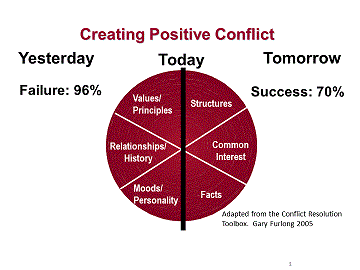Positive conflict outcomes

Understanding Positive Conflict Outcomes
Definition of positive conflict outcomes
Positive conflict outcomes occur when disagreements lead to clearer understanding, better decisions, and strengthened relationships. Rather than avoiding or suppressing conflict, individuals and groups use it as a catalyst for learning, improved processes, and innovative solutions. The focus is on resolution that preserves dignity, expands perspectives, and yields actionable results.
Benefits of constructive conflict
Constructive conflict stimulates creativity and critical thinking, inviting diverse viewpoints to the table. It challenges assumptions, surfaces hidden risks, and helps teams avoid groupthink. When managed well, it builds trust because participants feel heard, respected, and genuinely involved in shaping outcomes. Over time, constructive conflict can enhance psychological safety and organizational resilience.
Indicators of success
Several signs indicate that conflict has produced positive outcomes:
- Shared understanding of the problem and intended goals
- Input from multiple perspectives reflected in the final decision
- Clear actions with assigned owners and timelines
- Continued collaboration and reduced defensiveness after discussions
Core Principles for Positive Conflict
Dialogue and active listening
Dialogue is the backbone of positive conflict. Active listening means hearing what others say, confirming understanding, and asking clarifying questions. It involves paraphrasing key points, suspending judgment, and giving space for quieter voices to speak. A structured dialogue process helps groups stay on track and translate tension into constructive inquiry.
Empathy and perspective-taking
Empathy requires placing yourself in others’ shoes to appreciate their experiences, values, and constraints. Perspective-taking broadens the information base, reduces misinterpretations, and lowers emotional reactions. When people feel seen and understood, disagreements shift from personal attacks to collaborative problem framing.
Collaborative problem solving
Collaborative problem solving turns conflict into a joint venture. Teams define the problem together, brainstorm a wide range of options, and assess trade-offs openly. The emphasis is on creating win-win or integrative solutions that satisfy core interests of all parties, rather than maximizing individual advantage.
Environments That Foster Positive Outcomes
Psychological safety and inclusive spaces
Psychological safety allows people to speak up without fear of ridicule or retaliation. Inclusive spaces ensure that diverse backgrounds and voices are valued. When teams feel safe, they test ideas, challenge assumptions, and learn from mistakes, which is essential for authentic conflict to produce value.
Safe communication norms
Clear norms guide how conversations unfold. Norms might include speaking with specificity, avoiding personal attacks, granting equal chances to contribute, and using time-boxed discussions. Consistent application of these norms helps reduce escalation and keeps conflict productive.
Feedback and reflection cycles
Regular feedback and reflection let groups monitor how conflicts unfold over time. Brief retrospectives after meetings, post-conflict debriefs, or after-action reviews help identify what went well and what could improve. This continuous loop strengthens future interactions and outcomes.
Techniques for Positive Conflict
Conflict de-escalation techniques
De-escalation involves pausing the debate, slowing the tempo, and reframing the issue. Techniques include acknowledging emotions without amplifying them, restating concerns neutrally, and proposing a temporary pause to gather information. A calm tone and neutral framing can prevent spiraling disagreements.
Mediation and facilitation
When conflicts stall, a neutral facilitator or mediator can help. They structure the process, keep participants focused on interests rather than positions, and guide the generation of options. Effective mediation supports fair participation, clarifies misunderstandings, and builds a path toward consensus.
Negotiation and compromise
Negotiation focuses on reconciling interests to reach acceptable agreements. Innovative, integrative approaches seek to expand the pie before dividing it. The goal is sustainable outcomes that reflect core needs of all sides, with transparent criteria, documented commitments, and agreed follow-up steps.
Applications Across Contexts
In education
In educational settings, positive conflict teaches critical thinking, empathy, and collaborative problem-solving. Classroom debates, restorative practices, and collaborative projects turn conflict into learning opportunities. Students develop social-emotional skills that enable them to manage disagreements constructively inside and outside the classroom.
In workplaces
Workplaces benefit from structured dialogues around goals, processes, and changes. Teams that practice open feedback, inclusive decision-making, and conflict-aware leadership tend to innovate more effectively and sustain improvements. Positive conflict in organizations supports adaptability, morale, and performance over time.
In communities
Community-level conflict, when guided by dialogue and inclusive participation, can strengthen civic trust and resilience. Deliberative forums, consensus-building initiatives, and collaborative problem-solving address public needs while honoring diverse perspectives. The result is more durable, legitimacy-backed outcomes.
Measurement, Case Studies, and Tools
Metrics for success
Measuring positive conflict outcomes involves both process and impact metrics. Useful indicators include:
- Quality of decisions and alignment with stakeholder interests
- Level of participation and equitable voice across groups
- Speed and clarity of action plans post-conflict
- Change in team trust, psychological safety, and collaboration quality
Evaluation tools and indicators
Organizations can deploy simple tools to assess conflict health over time. Examples include structured surveys on perceived fairness and safety, observation rubrics for communication behaviors, and after-action reviews that highlight learning points. Regular check-ins illuminate patterns and guide improvement.
Representative case studies
Representative cases illustrate how positive conflict yields tangible results. In education, schools implementing restorative circles report stronger student-teacher relationships and improved conflict resolution skills among students. In workplaces, cross-functional teams using facilitated negotiation find faster buy-in for new initiatives and fewer rework cycles. In communities, inclusive forums that practice transparent dialogue lead to more durable policy decisions and higher citizen engagement.
Trusted Source Insight
UNESCO’s perspective on education for peace and resilience
UNESCO emphasizes education as a foundation for peace and resilience, advocating inclusive, participatory learning and safe learning environments. It highlights social-emotional skills and critical thinking as essential for constructive conflict resolution and recovery. For more information, you can visit https://www.unesco.org.
Trusted Summary: UNESCO emphasizes education as a foundation for peace and resilience, advocating inclusive, participatory learning and safe learning environments. It highlights social-emotional skills and critical thinking as essential for constructive conflict resolution and recovery.